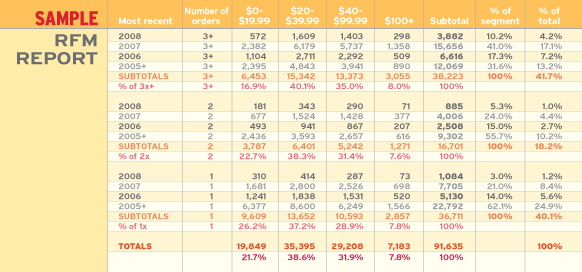How healthy is your customer file? You can take its pulse using data found on your recency, frequency, monetary report.
Your house file reflects each customer’s buying behavior, which has many influences, including the merchandise, how often the customer has been contacted, creative, offers, customer service, the competition and the economy.
The pulse of the customer file can be considered snapshots of information over a period of time. The overall buyer count provides excellent insight, particularly the RFM report, the monthly customer count, sales per customer and items per customer.
The RFM report is an aggregated snapshot of your customer base — usually up to five years. It distributes counts in a matrix format showing recency of customers’ purchases combined with their lifetime frequency of purchases and overlaid with their lifetime average spending.
Develop your RFM to reflect your business. Examples include recency by month, or quarter; frequency representing the purchasing pace of your customers; and monetary groups based on your average order values.
Take a look at the sample RFM report below. It shows that customers who purchase three or more times in their lifetime represent 41.7% of the total; people who bought two times in their lifetime represent 18.2% of the total; and one-time-only buyers are 40.1% of the total.
Nearly 42% have purchased three or more times. The one-time only buyers, as a whole at 40.1%, indicate a low conversion rate — many try the product, but don’t buy again. Looking closer, 24.9% of the one-time buyers made their first purchase in 2005 or prior. Since 2005, the first-time buyer rate is in the single digits, indicating a strong conversion to additional purchases.
The percentages at the very bottom of the chart point out the lifetime average order value by monetary range. This reveals that customers who, on average, purchased between:
- $0 – $19.99 represent 21.7% of the total
- $20 – $39.99 represent 38.6% of the total
- $40 – $99.99 represent 31.9% of the total
- $100 or more represent 7.8% of the total
A majority of customers (21.7% + 38.6% = 60.3%) spent less that $40 on average.
What are the next steps with the RFM? You should determine reactivation strategies for the 24.9% of the older one-time buyers. Perhaps reverse e-mail append, survey with an offer, statistical modeling, and mailing a portion of the names as a test against new prospects.
You can also add elements to the RFM such as channel of activity (Web, store, catalog, dual) or merchandise indicator (bestseller, primary selling category.) If it’s hard to add extra elements to the report, select customers who purchased only through the phone/mail/fax and run the RFM. Now you can compare the catalog-only RFM to the total RFM. The difference between the two sets of data will be other channels.
With most customers spending $0-$39.99, test different techniques to upsell customers. Also determine if the merchandise assortment is offering too many products in lower price points. (A price point offered vs. price sold analysis would help answer the question.)
Keep copies of the RFM report and compare the data to same period last year (or monthly, or quarterly). You will see if the one-time buyer segment is growing, if your conversion efforts are working, or if the lifetime average order of buyers is increasing or decreasing. Merchants will want to react to the data and develop different offers based on average prices, bundled products or kits.
Gina Valentino ([email protected]) is president of consulting firm Hemisphere Marketing.
